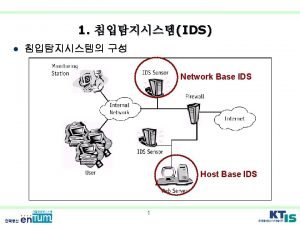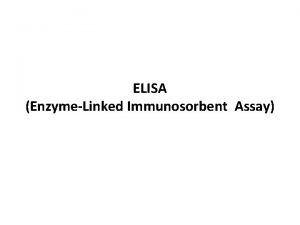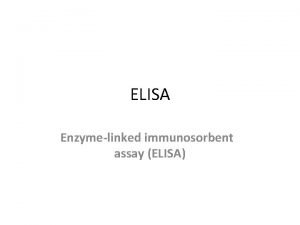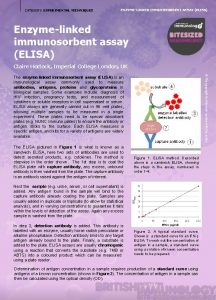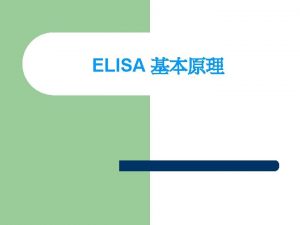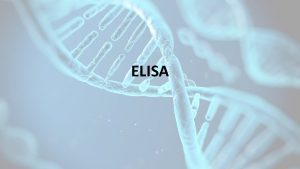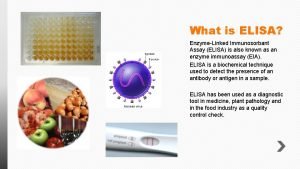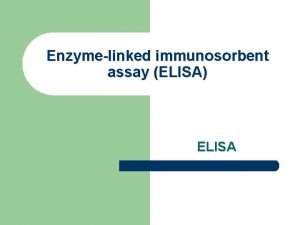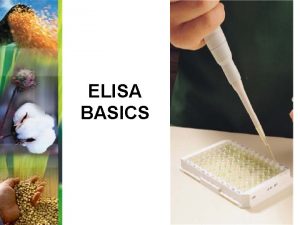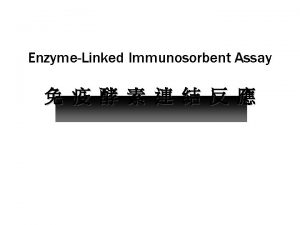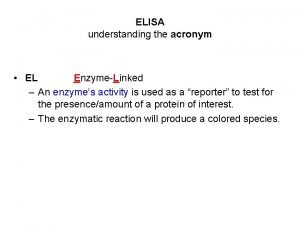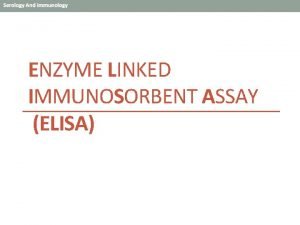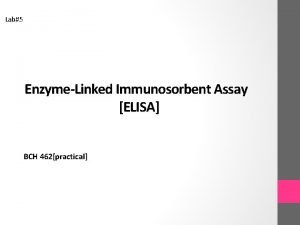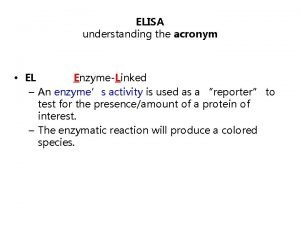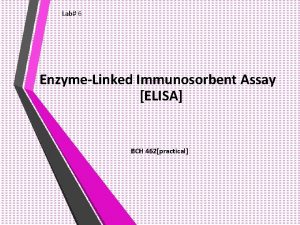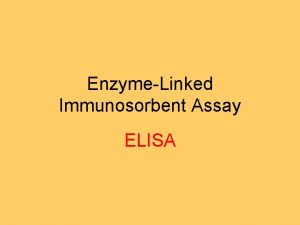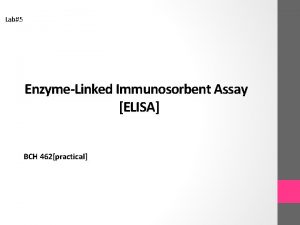ELISA part 2 Detection systems For all enzymelinked





































- Slides: 37

ELISA part 2

Detection systems • For all enzyme-linked immunoassays, the final stage is the addition of the enzyme substrate. The substrate is chosen for its quantitative yield of a colored, fluorescent or luminescent reaction product. • The decision as to which substrate is the best for any type of assay depends on the sensitivity desired, the timing requirements, and the detection device to be used. • Types of detection systems: – Colorimetric Assays – Fluorescent Assays – Luminescent Assays

ELISA assay variations • Colorimetric assays result in a colored reaction product that absorbs light in the visible range. • Fluorescent immunoassays (ELFIA) are simply a variation of colorimetric ELISA. An enzyme converts a substrate to a reaction product that fluoresces when excited by light of a particular wavelength. – In comparison to the colorimetric ELISA, fluorescent immunoassays are only slightly more sensitive.

• Luminescent immunoassays, like fluorescent immunoassays, are variations of the standard ELISA. An enzyme converts a substrate to a reaction product that emits photons of light instead of developing a visible color. – It is believed that luminescence is the most sensitive detection method currently in use due to the ability of signal multiplication and amplification

Microplate Reader • The microplate reader also known as “Photometric micro-plate reader or ELISA reader” is a specialized spectrophotometer designed to read results of the ELISA test • This instrument works on the principle of "Photoelectric Colorimetry" • Unlike the conventional spectrophotometer which facilitates readings on a wide range of wavelengths, the microplate reader has filters or diffraction gratings that limit the wavelength range to that used in ELISA, generally between 400 to 750 nm (nanometres). • Some readers operate in the UV range and carry out analyses between 340 to 700 nm.

• The optical system uses optic fibers to supply light to the microplate wells containing the samples. • A detection system (sensors) detects the light coming from the sample, amplifies the signal and determines the sample’s absorbance. • The location of the optical sensors of the microplate reader varies depending on the manufacturers: these can be located above the sample plate, or directly underneath the plate’s wells.

• Structure of antibody-coated microplate and treatment – 12 strips of 8 wells connected each other are set in a microplate frame. – The surface of the plate is covered with a seal to avoid dryness. Remove the seal after the plate gets to the room temperature. – Remove the seal just before starting assay. – If you want to use only a part of the wells, cut the part of the seal, and take out the strips and transfer them to another frame, and remove the seal. – store the rest of the wells at 2 -8 C.

• Washing – The first washing after the first reaction with standards or samples: Shake off the reaction mixture from the plate onto a sink. – Then add washing solution using a multidelivery pipette set at 250µl to avoid carryover caused by flowing out the buffer to other wells. Then shake off the buffer. – Add new washing buffer from the washing bottle with nozzle, and shake off. – Repeat filling and shaking off as many times as indicated.

• Washing solutions are usually concentrated and need to be diluted. 20 X : (1: 20)= 1 part of washing concentrate with 19 part of D. W, using volumes equivalent to number of wells to be washed. • For 8 wells, you require (8*350 ul = approx. 3 ml) • Take 3. 8 ml of DW with 200 ul of washing concentrate. (total= 4 ml).

• After final shaking off the buffer from the plate, strike the plate on to some sheets of paper towel for several times to remove the residual buffer üAutomatic plate washers are also commercially available

• Shaking of the well-plate for mixing – After addition of a reagent solution, the microplate should be shaken to mix the solutions. A short shaking is enough because of the small volume of the reaction mixture. microplate mixer (microplate shaker)

• Careful addition of reaction stopping solution – As the reaction stopper is strongly acidic, please, be careful in treatment of the solution. – After addition of the stopping solution the color of the reaction mixture in the well will change from blue to orange-yellow.

• Measurement of absorption using a plate reader – After stopping the enzyme action, absorbance is read using a densitometer for microplates (microplate reader). – If possible measure absorbance at both 450 nm and 620 nm, and calculate the difference between absorbance at 450 nm and 620 nm. – By doing this, we can compensate influences of some non-specific factors of wells like small scar on the bottom of well, and the variation in the structure of wells, e. g. , thickness of the bottom. – The difference is expressed as Abs. 450(∆620)nm.

• Preparation of standard curve and calculation of assay values – In manual calculation, prepare a standard curve using bi-logarithmic section paper by plotting Abs. 450(∆620)nm on Y-axis against standard concentration (ng/ml) on X-axis. – Because the coefficients of variation (CV) in absorbance do not change so much throughout all the assay range, it is proper to choose logarithmic expression in both concentration and absorbance. This expression allows easy reading of lower concentration area.

• Read the concentrations of the substance to measure in samples from their Abs. 450(∆620)nm, and multiply the assay value by sample dilution rate if samples have been diluted.

Important points in performing ELISA and improvement of assay performance �Sampling and treatments of samples – o o Serum or plasma? serum samples is most recommended In getting plasma: • • heparin is most often used as an anticoagulant Use of fluoride must be avoided because fluoride ion is a potent inhibitor of peroxidase. � An important phenomenon with frozen plasma is that an insoluble substance (fibrin) will be formed when thawed. • In this case, the sample must be vortexed and centrifuged, then the insoluble cluster flowing in the plasma should be taken out by a thin wire needle sharply bent at an end. If such fibrin remains in the sample, it may clog the tip of a pipette and influences assay variability.

�Storage temperature and freezing-thawing – Sample storage temperature is better to be lower than -35 C. – Ultra-low temperature such as -80 C is recommended for a long-term storage. – A long storage in a home freezer is not recommended because the sample is frozen very slowly and the solute may separate from solvent, and is concentrated at to the bottom of the storage tube – Repeated freezing and thawing is also harmful to the protein, and may cause inactivation.

• When samples are taken out from the freezer and thawed, never forget to vortex these samples because the solution after thawing is not homogeneous, and the bottom area contains more solute. • Stability of assay samples • In assay, the problem of sample stability, i. e. how long the substance to be measured can keep its immunoreactivity, in serum or plasma, is very important. Blood samples also contain enzymes to destroy peptides or proteins, and stability against those enzymes differs from substance to substance

• Most Kits have their own stability ranges; most of them have the following ranges: – Stability at room temperature: 2 hours – Stability at refrigerator temperature: 24 hours – Stability against freezing-thawing: 3 times – Stability for long period: at – 20℃ or-80℃

• Influence of humidity and air stream As ELISA is carried out in small volume of reaction mixture in shallow wells, the ratio of surface area to the liquid volume is large. This means that evaporation of water from the surface during incubation cannot be ignored. During all the incubation process, the well-plate should be covered using the attached plate cover.

• Pipettes • Selection of pipettes – Pipettes for samples and standard solutions are especially important because their precision directly influence the assay precision. When you add samples or standards at a volume of 5 or 10 µl, for example, use a pipette with the maximal setting volume of 5 or 10µl, and never use with the maximum setting volume of 100µl or more. In other words, use volume-matched pipette

Trouble shooting in ELISA 1 st , Coloration Troubles Possible Causes and Measures Poor or no coloration after the last step 1) The standard or samples might not be added. 2) Reagents necessary for coloration shown below might not be added. ①Biotin-labeled antibody ②HRP-conjugated avidin ③TMB or OPD 3) Contamination of enzyme inhibitor(s). 4) Influence of the temperature under which the kits had been stored. Freezing and thawing might cause denaturation of HRP-avidin conjugate. 5) Excessive hard washing of the well plate. 6) Addition of TMB solution soon after taking out from a refrigerator might cause poor coloration owing to low temperature. All the reagent solutions for ELISA should be used after fully warmed up to roomtemperature (20 -25°C)

Satisfactory absorbance was not The plate-reader might not be obtained by the plate reader; though adjusted to the correct wavelength the coloration is apparent to the eye. (450 nm for TMB). ⇒ Check the reader and adjust the wavelength. In the case of a filter-type plate-reader, check the wavelength of the filter, and replace for right one when wrong. All the wells showed high coloration. TMB solution might have been oxidized by some agents. .

2 nd standard curve Flat standard curve. All the wells for the standard curve showed very low coloration, though sample wells gave good coloration. Standard solutions are not added. In the dilution of original standard solution, other solution than the right original standard solution might be used, or simply the original standard solution was forgotten Absorbance of the standard decreased when standard concentration increased. Order of the standard solutions might be reversed. The standard curve obtained was not smooth There might be some mistake in the serial dilution of the original standard solution. Pay attention to volumes of standard and buffer solutions and enough mixing

The standard curve obtained moved toward right than that shown in the instruction paper. 1) The standard preparation might have been denatured. 2) The wrong initial dilution of the original standard solution. 3) The vortex mixing in the dilution of original standard solution might not be enough, and the mixture might not be homogeneous. 4) The reaction period might not be enough by any mistake.

3 rd samples Assay values were not obtained because samples gave lower absorbance than that of blank though the standard curve seemed to be normal. 1) In case Na. F-coated tubes are used, or Na. N 3 is added to assay sample as a preservative, they may influence the enzyme action of HRP though wells are washed before the addition of HRP-conjugate. The best way is not to use Na. F and Na. N 3. 2) Inactivation of the substance to be measured e. g during storage 3) presence of any interfering substances in blood samples=> serial dillution 4) Hemolysis. A slight hemolysis will not influence on assay value, however, too much hemolysis (hemoglobin concentration more than 40 mg/ml) may interfere significantly with the assay reaction. 5) p. H of serum/plasma samples. Blood samples like serum or plasma easily lose carbon dioxide soon after preparation, and p. H will become alkaline (> p. H 8) which may interfere with antigenantibody binding.

4 th, assay precision Big variation between two wells in duplicated assay was observed. 1) Scratching the bottom of the well by aspirator tip during aspiration of washing buffer. 2) Scratching the bottom of the well by pipette tip during addition of standards, samples, or reagents. 3) Insufficient removal of washing buffer from the wells might dilute reagent solution added in the following step of the procedure. 4) Assay variation due to pipetting

Advantages of ELISA High sensitivity High specificity relatively cheap and require small amounts of reagents rapid and can give both qualitative and quantitative results Detection is easy: results can be detected visually or using special readers Results are reproducible Automated, high throughput and manual methods are available, Very versatile No problems with radiation or disposal of waste Can use monoclonal or polyclonal antibodies.

Insulin like growth factor-1 (IGF-1) & IGFBP

Remember! • It has been found that growth hormone causes the liver (and, to a much less extent, other tissues) to form several small proteins called somatomedins that have the potent effect of increasing all aspects of bone growth. • Many of the somatomedin effects on growth are similar to the effects of insulin on growth. Therefore, the somatomedins are also called insulin-like growth factors (IGFs). At least four somatomedins have been isolated, but by far the most important of these is somatomedin C (also called IGF-1).

Somatomedin C (IGF-1) • The molecular weight of somatomedin C is about 7500, and its concentration in the plasma closely follows the rate of growth hormone secretion. • Some aspects of the somatomedin hypothesis are still questionable. One possibility is that growth hormone can cause the formation of enough somatomedin C in the local tissue to cause local growth. • It is also possible that growth hormone itself is directly responsible for increased growth in some tissues and that the somatomedin mechanism is an alternative means of increasing growth

• Measurement of serum IGF-I concentration is a sensitive screening test for acromegaly. • IGF-1 measurement before and after growth hormone therapy. • IGF 1 levels are dependent on the amount of growth hormones in the blood • Approximately 98% of IGF-1 is always bound to one of six binding proteins (IGF-BP). • IGFBP-3, the most abundant protein, accounts for 80% of all IGF binding. • Binding of these protein prolongs the half-life of the IGFs and alters their interaction with cell surface receptors.

Clinical Significance of IGFBP • They are used to diagnose and assess the degree of the human growth hormone (h. GH)-deficient state, and to measure responsiveness and predict the outcome of h. GH therapy of a patient. • They are also used in the differential diagnosis of growth disorders in order to elucidate the etiology of the disease. • In addition, IGF-1 and IGFBP-3, i. e. their ratio, can serve as safety biomarkers of h. GH therapy. • The IGF-1/IGFBP-3 ratio has sometimes been used as an index of IGF bioavailability in the human circulation, but this ignores IGF-1 binding to other IGFBPs (so the ratio is affected by the concentrations of all six IGFBPs)

IGFBP-1 • The most important regulator of circulating IGFBP-1 is insulin. Fasting insulin and IGFBP-1 concentrations are inversely correlated. • In insulin dependent diabetes(IDDM), serum IGFBP 1 levels are elevated. In non-insulin dependent diabetes, in which insulin levels are high, serum IGFBP-1 is decreased. • Low levels of IGFBP-1 have also been observed in the following cases: Acromegaly, Cushing’s syndrome and polycystic ovarian syndrome (PCO).

• The concentration of IGFBP-1 is correlated with glycemic conditions. • IGFBP-1 may be used for: – – monitoring insulin responsiveness, as a marker for insulin-producing tumors, monitoring acute fluctuations in insulin action and determining if poor glycemic control is due to inadequate insulin treatment or poor control of dietary intake.

Normal values IGFBP-1

! K R O W O GO T
 Name all the rays
Name all the rays Lightening radar
Lightening radar Intrusion detection systems (ids)
Intrusion detection systems (ids) Firewalls and intrusion detection systems
Firewalls and intrusion detection systems Fiber optic perimeter intrusion detection systems
Fiber optic perimeter intrusion detection systems Fspos vägledning för kontinuitetshantering
Fspos vägledning för kontinuitetshantering Typiska novell drag
Typiska novell drag Tack för att ni lyssnade bild
Tack för att ni lyssnade bild Ekologiskt fotavtryck
Ekologiskt fotavtryck Shingelfrisyren
Shingelfrisyren En lathund för arbete med kontinuitetshantering
En lathund för arbete med kontinuitetshantering Kassaregister ideell förening
Kassaregister ideell förening Tidbok
Tidbok Sura för anatom
Sura för anatom Densitet vatten
Densitet vatten Datorkunskap för nybörjare
Datorkunskap för nybörjare Stig kerman
Stig kerman Mall för debattartikel
Mall för debattartikel Delegerande ledarstil
Delegerande ledarstil Nyckelkompetenser för livslångt lärande
Nyckelkompetenser för livslångt lärande Påbyggnader för flakfordon
Påbyggnader för flakfordon Tryck formel
Tryck formel Publik sektor
Publik sektor Urban torhamn
Urban torhamn Presentera för publik crossboss
Presentera för publik crossboss Jiddisch
Jiddisch Bat mitza
Bat mitza Treserva lathund
Treserva lathund Mjälthilus
Mjälthilus Bästa kameran för astrofoto
Bästa kameran för astrofoto Cks
Cks Verifikationsplan
Verifikationsplan Mat för idrottare
Mat för idrottare Verktyg för automatisering av utbetalningar
Verktyg för automatisering av utbetalningar Rutin för avvikelsehantering
Rutin för avvikelsehantering Smärtskolan kunskap för livet
Smärtskolan kunskap för livet Ministerstyre för och nackdelar
Ministerstyre för och nackdelar Tack för att ni har lyssnat
Tack för att ni har lyssnat


